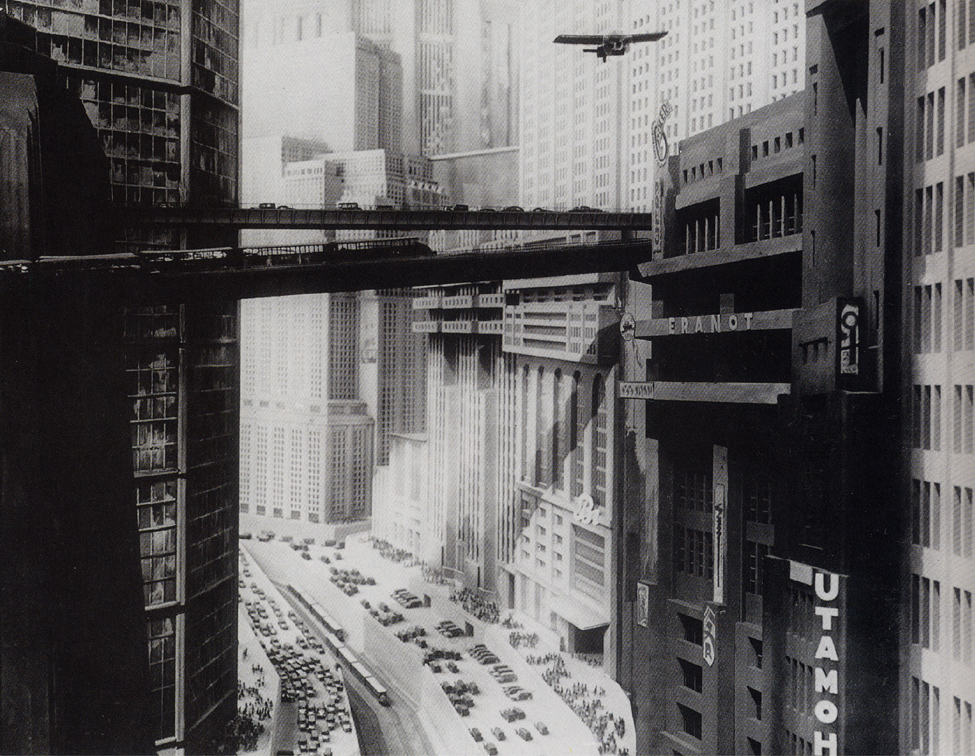
scene from Fritz Lang's Metropolis
CompLit 3607
Fall 2016
Texts: Swann's Way, Proust; Death in Venice,
Mann; Metamorphosis, Kafka; The Master and Margarita, Bulgakov;
Xeno's Conscience, Svevo.

scene from Fritz Lang's Metropolis
Impressionism:
 Renoir,
Renoir,
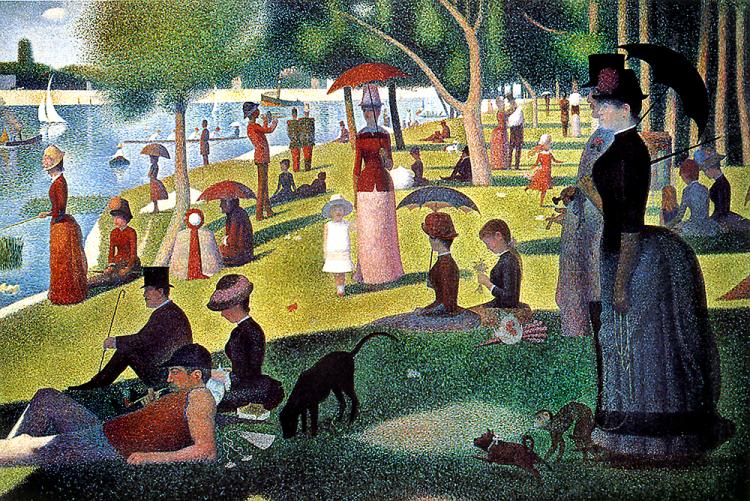
Seurat, A Sunday Afternoon on the Island of the Grande Jatte, 1886
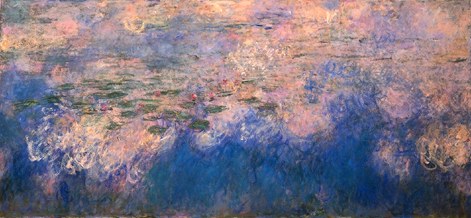
Toulouse Lautrec
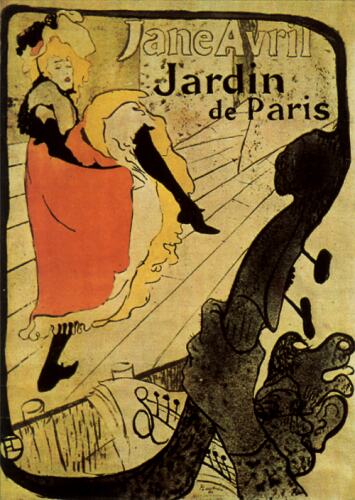

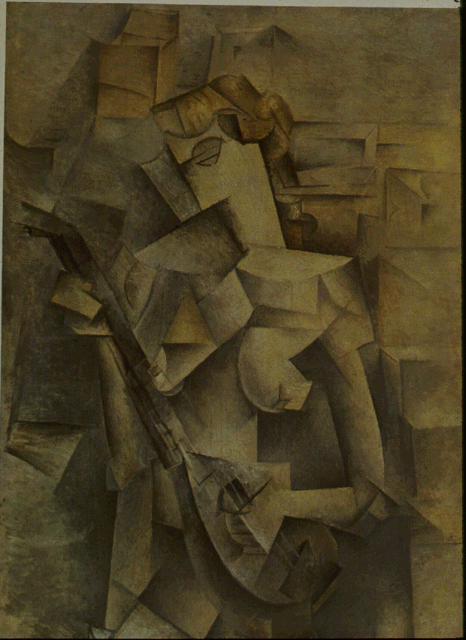
 Braque
Braque
Picasso, Les Demoiselles d'Avignon; la guitare
CompLit 3607, Modern European Novel:
Fall 2016 Prof. Moser
Office: 4232B
e-mail: jmoser @brooklyn.cuny.edu
Office hours: Mon., 2:15-3, Wed., 3:30-4:30
web site: academic.brooklyn.cuny.edu/english/moser
Course Objectives:
1. Students will read a selection of early 20th-century European novels by authors
from different European countries.
2. Students will analyze common themes and allusions in these novels, and relate
them to historical, cultural and social currents of the time.
3. Students will do close analyses of texts, discussing theme, imagery, poetic
technique.
4. Students will write three response papers, two 3-5 page papers and a final
research paper (5-7 pages) with appropriate documentation and format.
Required Texts: (available online and in the College Bookstore) YOU
MUST HAVE THE EDITION OF THE TEXT SPECIFIED IN THE SYLLABUS
Proust, Marcel. Swann's Way. Trans. Moncrieff, Kilmartin, Enright. Modern
Library, 2003.
Kafka, Metamorphosis. Trans. Corngold. Norton.
Mann, Thomas. Death in Venice. Trans. Koelb. Norton.
Bulgakov. Master and Margarita. Trans. Pevear and Volokhonsky. Penguin.
Svevo, Italo. Zeno's Conscience. Trans. Weaver. Vintage.
Course requirements:
1. There will be two short papers (3 pages, worth 10% and 15%), and one longer
final research paper (5-7 pages, worth 20%)
2. There will be 3 one-page response papers (15%).
3. There will be a midterm exam (15%).
4. Each student will be responsible for leading class discussion once during
the semester (10-minutes).
4. All work is due when assigned. One paper may be handed in late (your choice),
but no more than one week late. No other late work will be accepted.
5. There will often be quizzes at the beginning of the hour. These are graded
P/F. There are no make-ups for missed quizzes. Quizzes count towards the participation
portion of the final grade (10%)
6. Students are allowed three absences. Two latenesses = one absence. More than
three absences will result in a lowered grade.
7. Students who are absent from class are responsible for getting the assignment
from a classmate before the next class. Homework assignments will also be posted
on the web site. Do not e-mail me for the homework.
8. Failure to complete all assignments and/or excessive absence will result
in a lowered grade for the course.
9. Plagiarism will result in an automatic F for the course.
10. Possible grades range from A+ to F. The lowest passing grade is D-.
The two short papers are due according to the following schedule: see below
Group 1: Bastien, Fauci, Hassan, Lavino, Robinson, Smith, Shabanov
Group 2: Burroughs, Chevallier,Garcia, Itani, Mekonen, Sepulveda, Vasquez
Group 3: Casto, Emanuel, Golshan, Jerido-Katz, Melendez, Zhang
Grades:
15% -- response papers
10% - first 3-page paper
15% - second 3-page paper
15%---participation
15% --midterm
20%---final research paper
5%- discussion leader
5% - final presentation
**************************************************************************************************************************Background: Surrealist Manifesto: http://www.fordham.edu/halsall/mod/1925surrealism.html
World War I: http://www.wsu.edu/~dee/CRISIS/CRISIS.HTM
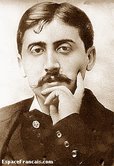 Marcel
Proust
Marcel
Proust
Monday, Aug. 29- Introduction and background
Wednesday, Aug. 31: read
through p. 10 in Swann's Way (handout).
Be prepared to discuss the opening paragraph and the description
of rooms, p. 7-10
Wednesday, Sept 7: read through
p. 168
Be prepared to discuss the goodnight kiss (48-52), the madeleine episode, (58-64),
the kitchen maid and Giotto (110-113); the hawthornes (155-58).
Discussion leader:
Monday, Sept 12 and Wednesday,
Sept 14: p. 168-332
Be prepared to discuss the two "ways" (188-90); hawthornes
and Gilberte (193-98); sadism (224-233); waterlilies (238 ,bottom-240); end
of Swann's Way (262-64); the little phrase (294-99); Odette and Botticelli (314-18);
cattleyas (328-32)
Discussion leaders:
Monday, Sept 19 and Wednesday, Sept 21: p. 332-471
Be prepared to discuss: art and love (335-39); the Verdurins
(354-56); jealousy (385, 391,-92, 396-97, 402-03); love and disease (432-34)
Discussion leaders: 9/19: Naomi; 9/21: Amanda L.
Monday, Sept 26 and Wed., Sept 28: p. 471-606
Be prepared to discuss: the little phrase again (490-98); lies
(520-29); Swann's dream (538-43); names (560-62); Allee des acacias (592-98);
return to the Bois (598-606)
Discussion leaders: 9/26: Sueann; 9/28: Rachel,
Viviane
Response papers: one page, double spaced, 12-point font: ; any passage you find particularly interesting (for example, life in Combray; the role of habit; snobbisim; portrait of Francoise}. Or, any sentence, episode, character you find interesting; or any of the topics highlitghted for each week's discussion---before we dicuss it in class.

Paper 1, Group 1 (10% of final grade) Due Mon. Sept 19
3. water lilies on the Vivonne, p. 238 (bottom)-240 (you might also look at
the Monet painting on the website).
4. different social faces: the portrait of Francoise.
5. Closing scene of "Combray": reiteration of previous themes
Paper 1, Group 2 (10% of final grade). Due Mon. Sept 26
1. love and music
2. love and art
3. jealousy
1. floral imagery in the closing scene of Swann's Way
2. close analysis of p. 551-560
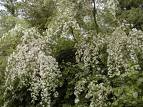 "It was in the
'Month of May' that I remember having first fallen in love with hawthorns"
(155).
"It was in the
'Month of May' that I remember having first fallen in love with hawthorns"
(155).
D
Botticelli's Zipporah "The Trials of Moses" (1481-82) Sistine Chapel,
Rome
"Her loosened hair flowing down her cheeks, bending one knee in a slightly
balletic pose . . . her head on one side, with those great eyes of hers which
seemed so tired and sullen when there was nothing to animate her, she struck
Swann by her resemblance to the figure of Zipporah, Jethro's daughter."
— Swann's Way

Botticelli's Madonna of the Pomegranate (1487) Galleria degli Uffizi,
Florence
"She [Odette] had at this moment their downcast, heart-broken expression,
which seems ready to succumb beneath the burden of a grief too heavy to be borne
when they are merely allowing the Infant Jesus to play with a pomegranate."
— Swann's Way
Worth gowns: http://www.metmuseum.org/toah/hd/wrth/hd_wrth.htm
Fortuny: http://www.metmuseum.org/toah/hi/hi_fort.htm
Art links (webmuseum) http://www.ibiblio.org/wm/paint/tl/20th/
Wednesday, Oct 5: Finish Proust
Death in Venice; Thursday, Oct 6 (conversion day)- Wed.,
Oct. 19:
Thursday, Oct 6: Read Chapters 1 and
2
Be ready to discuss:
Apollo and Dionysus symbolism
The “tempter” figures in the novella
The conflict between work and the sensual
1. Find all the ominous signs in Chapter 1 that foretell the author’s
dissolution
2. What is Aschenbach’s state of mind in the opening six paragraphs of
Chapter 1?
3. What is the narrative function of Chapter 2 ?
4. Find all the classical allusions in the descriptions of Tadzio. How does
associating Tadzio with classical Greek references help Aschenbach rationalize
his love of the boy?
Discussion leader: Amanda J-K.
Monday, Oct. 17: Read Chapter 3& 4
Pay closs attention to the classical allusions, the contrasts (Apollo/Dionysos)
Think about these topics:
In what ways does the image of Venice parallel the progressive degeneration
of Aschenbach?
Trace the evolution of the figures of death that accompany Aschenbach on his
journey from Munich to Venice.
Discussion leaders: Salvatore, Justine
Wed., Oct 19: Chapter 5
Also, read pages 83-88 on cholera; reading the "working notes" on
classical references, pp 72-83;
Discussion leader: Maddy
Read ONE of the following critical articles and write your response paper on that article: "Nietzsche and Mann," 130-149; or "Myth Plus Psychology," 115-130; or "Why is Tadzio A Boy?" 207-232.
lo spinario (boy with
thorn)
Monday, Oct 24: Finish Death in Venice; review for midterm
The following students will be responsible for looking closely at, and leading class discussion on, these topics about Death in Venice (you are not meant to work as groups, only for each individual to be particularly attentive to the topic of his/her group):
1. Find a series of short episodes that represents a recurrent leitmotif: (students
in Writing Group 1)
2. the portrayal of Aschenbach's thoughts and emotions in response to what happens
to him (a number of waking dreams, one actual dream): (students in Writing Group
2)
3. general reflections on the action that are difficult to attribute (are they
the narrator's or the main character's?) (students in Writing Group 3)
4. allusions to other texts: all students
5. the distancing techniques of the narrator: All students
Everyone: Look at all these strands and see how Mann weaves them into the overall
narrative of the novella.
(from study questions, ucdavis, hum 103)
Wednesday, Oct 26: Midterm: Proust, Mann
3 Parts: Identifications; Quotes; Short (paragraph) responses
REVIEW NOTES FOR MIDTERM:
CMLT 3606 midterm review: Proust and Mann
The exam will have 3 parts:
I.Identifications (2 pts each; choose 12 out of 15) 24 points
II. Quotations: (8 points each; choose 6 out of 9) 48 points
III. Short essays: (7 points each; choose 4 out of 7), 28 points
For the Identifications part---keep in mind that these are only worth 2 points
each and don't spend too much time on each answer. One or two sentences will
do. You should be able to identify the main characters in each work, time periods,
classical and artistic allusions, stylistic terms (see below), cultural influences,
artistic movements.
For the Quotations part----each quote will require 3 answers: a) source, 1 point;
b) who is speaking and what are the circumstances, 2 points; c) the relevance
of the quote to the work---why is it important? What does it show?, 5 points.
For the short essays----these will be topics that we discussed in class, and
will include an option of close reading of a passage from Proust or Mann.
How to prepare:
Look at the website---anything that is mentioned on the website, whether it
is social, historical or cultural background or directly taken from the two
books, may show up on the midterm.
No tricks; nothing obscure. If there is a quote in section II, it is taken from
a section that we looked at in class. If there is an essay topic, it is something
that we discussed in class. Go over your notes from class to review the important
themes we discussed for each work.
Background: you should know what technological and scientific advances, what
social, philosophical and artistic movements influenced the changes in the ways
that people perceived the world at the turn of the century. Here are some common
themes we discussed in both works:
Time (psychological rather than linear); relativity; alienation; isolation;
changes in the structure of society; perspective (time and distance); fashion;
homosexuality; art; music; appearance vs. reality; memory; disease as metaphor
in both works; weak heroes; importance of dreams
What makes these works modern:
19th c literature---outward-individual and society; realism
20th c literature---inward; psychological action; weak heroes; psychological
sense of time; dreams---blurring of waking and sleeping worlds
Style:
For Death in Venice: Free indirect discourse; irony; narrative distance;
dactylic hexameter; classicism; oppositions (Dionysos/Apollo; Venice/Munich;
emotions/intellect; water/landlocked; east/west; open fist/clenched fist, etc……..)
For Swann's Way: psychological style; impressionism; oxymoron; juxtaposition;
sensory appeals; artistic allusions; metaphor; simile; circular composition;
polysyndeton; asyndeton (we discussed this)
For Death in Venice: recurring themes----disease; water; exoticism;
tempter figures; the color red; classical beauty; dreams; love; death; art
For Swann's Way: recurring themes-----disease; art (painting-Botticelli;
music-Vinteuil); society; isolation; loneliness; mother-son relationship; involuntary
memory (madeleine episode); synesthesia; jealousy; love
This list of themes is not finite----you can add more themes...
See you all in class on Wednesday. Email me with any questions you may have.
Metamorphosis
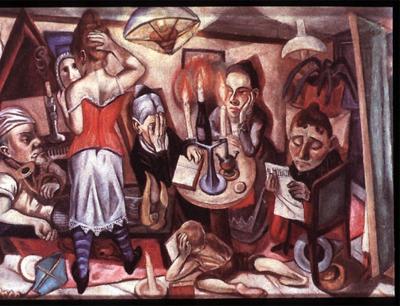 Max Beckmann, Family
Portrait (cover of 1920 edition of Metamorphosis)
Max Beckmann, Family
Portrait (cover of 1920 edition of Metamorphosis)
Monday, Oct. 31: Kafka
Be prepared to discuss the following in class (this is not meant to be handed
in):
1. Questions for Section 1 (p. 3-15):
a. Briefly outline everything significant that happens in this section.
b. How much time goes by in this section? How do you know this? Support your
answer with at least 2 pieces of evidence from the text. Be sure to indicate
the exact place in the text that the reference comes from.
c. What point of view is the story told from? Again, support your answer with
two pieces of evidence.
Here's an interesting article by Vladimir Nabokov on Metamorphosis:
http://www.kafka.org/index.php?id=191,209,0,0,1,0
And here's a link from an historian at Univ. of Pennsylvania that might provide
some very interesting ideas for a final paper:
http://www.upenn.edu/nso/prp/met/breckman_lecture.html
Wednesday, Nov. 2, Kafka
2. Questions for Section 2 and 3?(p. 15-29)
a. How much time goes by in this section of the story? How do you know this?
Again, quote from the text to support your answer.
b. How does the tone change in this second section? Try to find a passage from
the second section to compare to a similar passage from the first. Show how
the mood has changed from Section 1 to Section 2.
3. Questions for Section 3 (p. 29-42)
a. Summarize the significant events of this section.
b. Does the tone in the third section change? If it does, explain how.
c. Think about the number 3 as a recurring motif in the story.
Discussion leaders: Kimberly G., Karina
Monday, Nov. 7: Kafka
Choose one of the critical essays in the back of the book and 1) summarize
the main arguments of the essay; 2) respond to the author's argument---did you
find it convincing? why or why not? did it add to your understanding of the
novella? how?
Discussion leader: Rayan
GROUP 1, PAPER 2 DUE WEDNESDAY, NOV 9
1. Pick one paragraph of the story that seems to you to be characteristic
and significant, and analyze it from the point of view of vocabulary, sentence
structure, imagery, narrative. Look carefully at how it is written, what is
included, excluded, left unsaid. What is Kafka trying to convey in this paragraph?
2. There is a change in tone between the first and second sections. Find a passage
from the second section to compare to a similar passage from the first section.
Show how Kafka conveys a change in mood from section 1 to section 2.
3. Do a Marxist analysis of the story.
4. Kafka wrote in his diear, a few months before he began Metamorphosis, "Thoughts
of Freud, naturally..." Examine Freudian concepts in thie story.
5. Investigate the theme of alienation in the story.
Wednesday, Nov. 9: Bulgakov
Master and Margarita
Read Chapters 1-8
Check this link for lots of information on Master and Margarita:
http://cr.middlebury.edu/public/russian/Bulgakov/public_html//intro.html
Discussion leaders: Shaquille; Jenny
Monday, Nov. 14: Bulgakov
Read Chapters 9-16.
Discussion leader: Serena
Wed, Nov 16: Bulgakov
Read Chapters 17-23.
Be prepared to discuss the manipulation of time and space at the Devil's ball;
or describe the positive traits of Margarita; the satirical look at the bureaucracy
in Chapter 17; pick any theme or passage you want to analyze.
Discussion leader: Kimberly B.
PAPER 2, GROUP 2: DUE WED., NOV 23 (MASTER AND MARGARITA); You may also choose
this date and topic if you are in Group 3 and want to be finished sooner
1. Trace the moon and sun imagery in Master and Margarita.
2. How do the two main story threads of the novel --- the Biblical (Yerhalaim
around 33) A.D. and the secular (Moscow in the 1920)s----interact? Be sure to
discuss theme, imagery, setting, and style in your analysis.
3. Compare the scene at the Devil's Ball with the scene at Herod's palace.
4. Pick any chapter, and do a close analysis of the themes, imagery, allusions.
5. Trace either the color or the flower motifs in the novel.
6. Woland---what kind of devil is this?
Mon, Nov 21: Bulgakov
finish Master and Margarita
Discussion leaders: Joshua, Roman
Wed. Nov 23: Svevo
Read and be prepared to discuss pages 1-100 of Zeno's Conscience.
Discussion leader: Rayan
Hand in paper proposal by NOV 30: .A clear, limited topic for your paper,
stating the question that you will explore and the argument you will make.
A list of at least 3 secondary sources (some of these can come from the Norton
critical editions we have been using). This should be in MLA format.
A list of at least 3 passages from the primary text that you will analyze closely
in your paper as support for your argument. You will not merely summarize the
passages, but rather subject them to a close, detailed reading that yields evidence
to support your argument.
In-class presentations: December 7-December 14: The last 3 class sessions will
be devoted to presentations (5 minutes) on your final research paper
These presentations will be brief (5 minutes), and will, I hope, be organized
loosely by topic. Ideally, the class will be divided into groups by novels or
themes, and the presentations will be grouped accordingly. You must e-mail
me your annotated bibliography the day before your presentation. If you are
absent on the day you are supposed to present, you will be able to present ONLY
if there is sufficient time on the last day class meets (Dec. 14). If you do
not present, your final paper grade will be reduced by one letter grade.
Mon., Nov 28: Svevo
Read through p. 197
Continue discussion of Zeno's Conscience. Be prepared to discuss
the dreams in the novel. Discussion leader: Lasheila
Wed, Nov 30: Read through p. 316 in Zeno's Conscience.
Monday, Dec. 5: Svevo
Finish Zeno's Conscience.
GROUP 3, PAPER 3 DUE WED., DEC. 7 (ZENO'S CONSCIENCE)
Choose one of the following topics. Be sure to make specific references to the
text.
1. Zeno as anti-hero.
2. Zeno, pessimist or optimist?
3. Describe three paradoxes in the novel. In what ways do they typical of Zeno?
4. Smoking as a symbol of the "hopeless hope" that permeates the novel.
Wed., Dec 7-----presentations: Amanda L; Rayan; Amanda J-K; Karina; Viviane; Justine; Joshua; Roman; Shaquille
Monday, Dec 12----presentations: Jenny; Naomi; Serena; Sal; Maddy; Lasheila; Kimberly; Rachel; Sueanne THIS DAY IS NOW FULL
.Final Paper (in my mailbox or e-mailed by Dec. 19)
Choose one of the topics below as the subject for a 5-7 page paper. This paper
requires at least three outside sources ; the primary texts should serve
as your main reference. Be sure to proofread carefully, be specific, avoid retelling
the plot, and document any quotes you use.
No late papers will be accepted.
1. The theme of travel in Death in Venice
2. Choose any two novels we have read; The hero as a symbol of the isolation and alienation of the modern world.
3. Art as a metaphor in Proust and Mann.
4. The cult of the individual in two of the novels we have read.
5. Portrait of early twentieth-century society in Proust, Svevo, Bulgakov.
6. Narrative voice in Kafka
7. Sickness and health as metaphors in Svevo and Mann.
8. Irony in Bulgakov and Svevo.
9. Music in two of the following: Death in Venice, Metamorphosis, Swann's Way.
10. Nietzsche and Mann.
11. Dreams in Death in Venice, Swann's Way, Metamorphosis.
13. If “the eyes are the mirror of the soul, how does the gaze function in Death in Venice?
If you have a different topic that you want to write about, please be sure to clear it with me before you start.